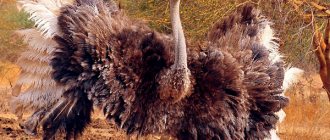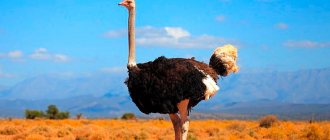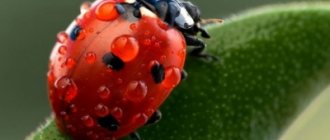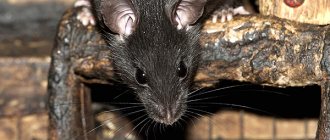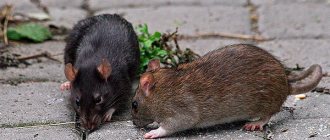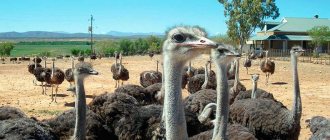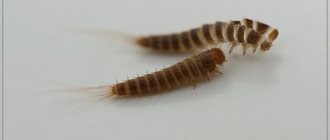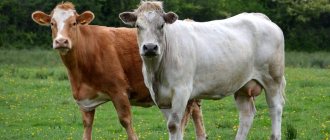Description of the bird
Description of the ostrich bird photo
– Advertising –
The ostrich is the largest bird today. Their height reaches 3 m, weight – 150 kg. The physique of ostriches is dense with a long neck and a flat, small head. The straight, flattened beak is decorated with a growth. The eyes are large with fluffy eyelashes. The wings of ostriches are not sufficiently developed, so the birds cannot fly. But their legs with two toes are very strong. On one finger there is a semblance of a hoof - a support for running.
Ostrich feathers
The ostrich is feathered all over its body except the neck, head and thighs. There is also an unfeathered area of skin on the bird's chest, in the place on which the ostrich rests when lying down. The feathers of an adult bird are curly and loose. Males are black with white wings and tail. The female is distinguished by a gray-brown color with a grayish-white tail and wings, and is smaller in size compared to the male.
Origin and domestication of birds
Origin and domestication of the ostrich photo
The first ostrich farm was established in South Africa in 1838. The reason then was not so much the mass extermination of ostriches, but rather the interest in obtaining the valuable feathers of this bird. At that time, it was very fashionable to decorate clothes and hats with lush ostrich feathers. And the business of breeding ostriches was as profitable as gold mining. To get as many feathers as possible, farmers did not pluck them out, but carefully trimmed them, giving them the opportunity to grow back. From Africa, ostrich breeding spread to Europe, the USA, Australia, and South America. Statistics from 1913 indicate that about a million ostriches were raised on farms. In the twentieth century, ostrich farming fell into decline, but in recent decades it has regained popularity, this time thanks to the valuable dietary ostrich meat. Today there are about 600 ostrich farms in Europe. The birds are unpretentious, grow quickly, produce a lot of valuable products, so keeping them is a success.
Where to see them
We invite you to get to know these amazing birds better at the Izborsky Ostrich farm. It’s easy to find us, we are located in the Pskov region, Pechora district, in the city of Izborsk, the village of Zalavye. With us you can
- watch the ostriches,
- hear interesting stories about them,
- look at the little ostriches, and also
- try ostrich meat (250-950 rubles/kg).
Liver, heart, and neck are also on sale. There is a cozy cafe on site.
Share the link with your friends:
Ostrich breeds
Black African ostrich
Black African ostrich photo
From Greek, the specific name of the African ostrich is translated as “camel sparrow”. This large bird reaches 270 cm in height and up to 180 kg in weight.
Speed
The speed of the black African ostrich is 60-70 kilometers per hour, depending on the age of the bird (stride length 3.5-4 meters). The bird is unpretentious in breeding, tolerates temperatures from -25 to +35 ° C, and gets used to humans well. However, it requires a lot of food and needs space for walking.
Ostrich Emu
Ostrich emu photo
The breed reaches a height of 180 cm, the weight of an adult bird is up to 60 kg,
Speed
The running speed of an emu is 45 - 50 kilometers per hour, depending on age. The strong legs of the emu are distinguished by the fact that they have three toes with a developed and sharp claw on the inner toe. Sexual dimorphism is not typical for the emu, so it is very difficult to distinguish a male from a female.
South American ostrich (rhea)
South American ostrich (rhea) photo
This species is smaller than its relatives. The height of the rhea is 1.5 m. It differs from the African ostrich by the presence of plumage on the neck.
Keeping an ostrich in the household
Keeping an ostrich in the household photo
In the summer, ostriches are kept outdoors in spacious pens, which are fenced with a metal mesh (mesh size 30 cm by 30 cm). The height of the fence should be at least 2 m, as the bird may try to jump over it. Wooden or brick poultry houses with a ceiling height of about 3 m are suitable for wintering ostriches. 10 m2 of room are allocated for one adult bird. The floor of the poultry house is lined with straw and shavings, making dry litter. Part of the stall is covered with sand so that the ostriches can take their favorite sand baths. During the mating season, males dig small holes in the floor for further arrangement of the nest. Such depressions are filled with clean sand, and then the females lay eggs there. It is also important to consider that males become very aggressive during the mating season. Feeders for ostriches are placed under canopies at the rate of 1.5 m per adult bird and 0.5 m per chick. Birds should have plenty of room at the feeders to avoid crowding. The feed containers are made comfortable, about 1 m in height, and stable, filled to a maximum of 2/3. At a height of 0.5 m from the floor, you can also attach separate mangers for hay and grass. Large troughs are used as drinking bowls.
Ostrich chicks
Ostrich
chicks hatch almost simultaneously in a clutch. The difference between the first and last is usually no more than three days. Sometimes the baby has to spend many hours to completely free himself from the shell. It helps to break up the dense horny growth on the beak. Due to its prickly bristle-like down, the hatched ostrich resembles a hedgehog rather than a chicken. For the first time in their lives, ostrich chicks can hardly lift their heads.
They do not eat for 24 hours and gain the ability to follow their parents only 48 hours after they are born. From this moment on, the chicks can already run away in case of danger. If they notice pursuit, they scatter to the sides, and then suddenly rush to the ground and freeze.
Interesting: Armadillos - description, habitat, food, enemies, photos and videos
At this time, the parents are trying to divert the enemy's attention. The female runs in one direction, the male in the other; they both make great zigzags and drag their wings as if they were broken. If a predator begins to chase one of the adults, the second one stops pretending and tries to take the chicks away. To protect the ostrich chicks from the sun's rays, the mother gathers them under her wings. Chicks remain a tasty prey for predators for a long time; the mortality rate among them is quite high.
At two months, ostrich chicks lose their bristly down, and their plumage becomes the same as that of adult females: the difference in plumage between males and females is not visible until they are two years old. Up to nine months, the chicks go to a kind of “nursery”, where they are watched by one or more adult birds. Young animals reach full maturity only at three to four years of age.
Nutrition and feeding for the ostrich
Nutrition and feeding for an ostrich photo
The basis of nutrition for an ostrich of any age is green grasses and flour in the summer and silage in the autumn-winter. Small pebbles are poured into a separate feeder for the ostrich, which the bird swallows as needed as food grinders. This kind of “complementary feeding” is also needed for chicks older than 3 weeks. The daily diet for an adult ostrich includes 1.5 kg of feed, chopped hay and green mass. Depending on the appetite and general condition of the birds, the amount of feed is increased to a maximum of 2-3 kg, while mixing it with green food.
What do they eat?
The African ostrich is an omnivorous bird. They eat mainly food of plant origin:
- leaves,
- grass,
- roots,
- leaves.
At the same time, they may well feast on small insects or animals - lizards and bugs. Original facts about ostriches: these birds can eat things that other animals cannot digest. They have a special structure of the muscular system of the stomach. Even the coarsest food is digested with the help of swallowed small stones and sand.
Ostrich breeding
Breeding ostriches photo
In the wild and on farms, ostriches are polygamous. For every male in the family there should be from 3 to 5 females. During the mating season, males become aggressive, their legs and neck turn bright colors, and they trumpet and hiss.
Nest
The male digs a common nest with a depth of 30 to 60 cm, into which all females lay eggs once every 2 days. The dominant female lays eggs in the center of the clutch, and she begins incubation. Interestingly, the eggs are incubated by the male and dominant female ostriches in turn. Males - at night, females - during the day. Incubation duration is from 35 to 45 days.
Ostrich eggs
Ostrich and its eggs photo
Ostrich eggs are the largest among bird eggs. They reach a length of 20 cm, their weight is from 1.5 to 2 kg. The shell is also unusually thick - 0.5 cm, yellow, sometimes white or dark. The total clutch in northern Africa is up to 20 eggs, in the south - about 30, in the east the number of eggs reaches 60.
Economic importance
The interesting external characteristics of the African ostrich almost led to the extinction of the species - the beautiful feathers of the males were used to make fans, plumes, fans, and hat decorations. This caused the mass extermination of birds and an imbalance between females and males.
Over time, people began to raise ostriches in captivity - they are bred for meat, skin, and eggs. Birds are no longer killed to collect feathers - the feathers are carefully trimmed near the skin. The procedure is repeated 1-2 times a year, starting from the age of two. Craftsmen use egg shells to make decorative dishes and even real works of art.
Raising chicks
Raising ostrich chicks photo
Dimensions
Newborn ostrich chicks are about 20 cm in height. They grow at a rate of about 1 cm per day to a value of 150 cm.
Feeding
For the first three days, it is recommended not to feed or drink babies so that their gall sac resolves. The ambient temperature is maintained at 32-33°C. On the fourth day, the ostrich chicks are given a mixture of crushed clover or alfalfa leaves with mixed feed (as for broiler chickens) and water. At the same time, they begin to give cottage cheese and boiled eggs. At the 5th week of life and up to 3 months, the chicks are fed with compound feed, as for broiler chickens. Be sure to place separate feeders with gravel or small stones. Young ostrich chicks switch to grass food in the summer, eat root vegetables (potatoes, carrots, beets) in the fall, and eat silage in the winter.
Hard shell
Ostrich eggs have very hard shells . Because of this, it takes the chick about an hour to crawl out, and not all of them cope with this. In those who do get out of the egg, you can often see a hematoma on the back of the head, as they broke their way out with their heads. This hematoma is not dangerous and goes away quickly.
Some birds of prey that feed on ostrich eggs throw stones onto them from a height, since they cannot break the strong shell with their beaks.
Since ancient times, people have used ostrich egg shells for household needs. In one of the caves of Altai, jewelry made from them was discovered, the age of which is more than 50 thousand years . And a number of African tribes still use these shells as vessels for water.
Interesting facts about ostriches:
- During the extraction of feathers, ostriches were almost completely exterminated in the 18th century. Fortunately, they began to be bred on farms, and the birds were saved. Today, ostriches are bred in 50 countries around the world (and even in northern countries such as Sweden).
- A female ostrich that hatches eggs, in the event of a dangerous situation, spreads her head and neck on the ground, trying to be as unnoticeable as possible. Birds do the same if there is a predator nearby. This is why the idea arose that when in danger an ostrich buries its head in the sand.
- An adult ostrich can easily support the weight of an adult. The males are even ridden.
